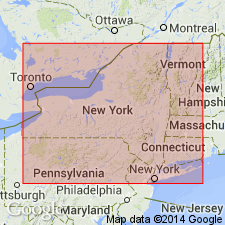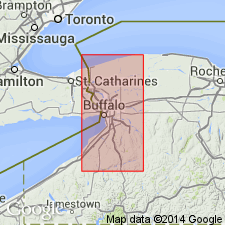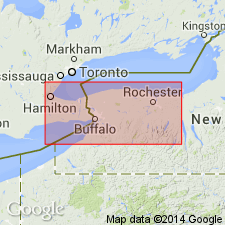
- Usage in publication:
-
- Ancaster Dolostone Member
- Modifications:
-
- Areal extent
- Dominant lithology:
-
- Dolostone
- AAPG geologic province:
-
- Appalachian basin
Summary:
Beds overlying the Niagara Falls Member of the Goat Island Formation are assigned presently to the Ancaster and Vinemount Members of the Goat Island Formation. Both of these units have their type sections near Hamilton, Ontario. The Ancaster overlies the Niagara Falls Member. The lower 0.5 m consists of flaggy beds of pale buff-weathering, fine-grained dolostone that contain the chert nodules that characterize the Ancaster Member in its type area. The overlying interval is medium to thick-bedded, buff colored, medium-grained and generally non-cherty dolostone. Contains a distinctive layer of silicified valves of WHITFIELDELLA brachiopods. Age of the Goat Island and its members is Middle Silurian.
Source: GNU records (USGS DDS-6; Reston GNULEX).

- Usage in publication:
-
- Ancaster Member
- Modifications:
-
- Overview
- AAPG geologic province:
-
- Appalachian basin
Summary:
Lockport Group in this report is considered Late Silurian following Rickard (1975) as the NY Geological Survey does not recognize Middle Silurian as does the USGS. The revisions to the Lockport nomenclature discussed in this report will be formally proposed by C.E. Brett in a larger study of the Niagaran Series. The Lockport Group is divided into the (ascending) Gasport Limestone, the Goat Island Dolomite, the Eramosa Dolomite, and the Guelph Dolomite. The Gasport includes the Gothic Hill and Pekin Members, and the Goat Island includes the Niagara Falls, Ancaster, and Vinemount Members. [Though three of the authors of this report (Tepper, Kappel, and Yager) are USGS scientists, the nomenclature used here was not officially accepted for use by the USGS Geologic Names Unit at time of compilation.]
Source: GNU records (USGS DDS-6; Reston GNULEX).

- Usage in publication:
-
- Ancaster Member*
- Modifications:
-
- Revised
- Dominant lithology:
-
- Dolomite
- Chert
- AAPG geologic province:
-
- Appalachian basin
Summary:
Ancaster Member of the Goat Island Dolomite, named for Ancaster, Ontario, CAN, is formalized in this report. Consists of medium ash-gray, thin- to medium-bedded, fine-grained dolomite that weathers light tan and contains abundant chert nodules. Fossils include rugose corals, brachiopods, gastropods, and rare trilobites. Thickness ranges from 2 ft at the south end of the Niagara River Gorge to 25 ft at the type locality. Conformably overlies the Niagara Falls Member of the Goat Island Dolomite and conformably underlies the Vinemount Member of the Goat Island Dolomite. West of Hamilton, Ontario, CAN, unit grades laterally into massive carbonates of the Amabel Formation. East of Clarendon, NY, it merges with thinly bedded sandy dolomite of the Penfield Formation. The Ancaster is of Late Silurian (early Ludlovian) age based on conodonts. [Report uses Silurian time scale of Harland and others (1982).]
Source: GNU records (USGS DDS-6; Reston GNULEX).
For more information, please contact Nancy Stamm, Geologic Names Committee Secretary.
Asterisk (*) indicates published by U.S. Geological Survey authors.
"No current usage" (†) implies that a name has been abandoned or has fallen into disuse. Former usage and, if known, replacement name given in parentheses ( ).
Slash (/) indicates name conflicts with nomenclatural guidelines (CSN, 1933; ACSN, 1961, 1970; NACSN, 1983, 2005, 2021). May be explained within brackets ([ ]).

